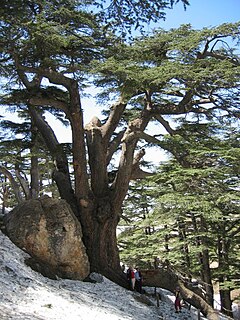
The Lesser Antilles are a group of islands in the Caribbean Sea. Most of them are part of a long, partially volcanic island arc between the Greater Antilles to the north-west and the continent of South America. The islands of the Lesser Antilles form the eastern boundary of the Caribbean Sea where it meets the Atlantic Ocean. Together, the Lesser Antilles and the Greater Antilles make up the Antilles. The Lesser and Greater Antilles, together with the Lucayan Archipelago, are collectively known as the West Indies.

The Antilles is an archipelago bordered by the Caribbean Sea to the south and west, the Gulf of Mexico to the northwest, and the Atlantic Ocean to the north and east.
The Leeward Islands are a group of islands situated where the northeastern Caribbean Sea meets the western Atlantic Ocean. Starting with the Virgin Islands east of Puerto Rico, they extend southeast to Guadeloupe and its dependencies. In English, the term Leeward Islands refers to the northern islands of the Lesser Antilles chain. The more southerly part of this chain, starting with Dominica, is called the Windward Islands. Dominica was originally considered a part of the Leeward Islands, but was transferred from the British Leeward Islands to the British Windward Islands in 1940.

Cedrus libani, the cedar of Lebanon or Lebanese cedar, is a species of tree in the pine family, native to the mountains of the Eastern Mediterranean basin. It is a large evergreen conifer that has great religious and historical significance in the cultures of the Middle East, and is referenced many times in the literature of ancient civilisations. It is the national emblem of Lebanon and is widely used as an ornamental tree in parks and gardens.

Podocarpus is a genus of conifers, the most numerous and widely distributed of the podocarp family, the Podocarpaceae. The name comes from Greek πούς + καρπός. Podocarpus species are evergreen shrubs or trees, usually from 1 to 25 m tall, known to reach 40 m (130 ft) at times. The cones have two to five fused cone scales, which form a fleshy, berry-like, brightly coloured receptacle at maturity. The fleshy cones attract birds, which then eat the cones and disperse the seeds in their droppings. About 97 to 107 species are placed in the genus depending on the circumscription of the species.

The following is an alphabetical list of countries in the United Nations geoscheme for the Americas grouped by subregion and intermediate region. Note that the continent of North America comprises the intermediate regions of the Caribbean, Central America, and Northern America.
The law of North America is diverse and influential. The law of the United States has worldwide renown, in its codified constitution, and bill of rights, while the law of Cuba differs vastly in its regulation of private property. The first court of justice was established in Newfoundland and Labrador, Canada in 1615 by Sir Richard Whitbourne as a court of admiralty at the future site of Trinity, Newfoundland and Labrador.
The 2007 CFU Club Championship was the annual international football club competition held in the Caribbean Football Union (CFU) region. Nineteen teams were to compete in the tournament, from November 4 to November 16 in six venues in Trinidad and Tobago. The first round consisted of five groups played in a round-robin format. The first round group winners along with the three best second-place teams advanced to the quarterfinals. The Caribbean Tournament Champion qualified to the 2008 CONCACAF Champions Cup.
Podocarpus celatus is a species of conifer in the family Podocarpaceae. It is found in the Amazon rainforest.

Podocarpus costalis, locally known as arius, is a species of conifer in the family Podocarpaceae. It is native to the Philippines and Taiwan.

Podocarpus nivalis, the mountain or snow tōtara, is a species of conifer in the family Podocarpaceae. It is endemic to New Zealand.

Podocarpus sprucei is a species of conifer in the family Podocarpaceae. It is found largely in Ecuador and Peru.
Retrophyllum vitiense is a species of conifer in the family Podocarpaceae. It is a large evergreen rainforest emergent tree native to Fiji, Indonesia, Papua New Guinea, and Solomon Islands.
The Caribbean bioregion is a biogeographic region that includes the islands of the Caribbean Sea and nearby Atlantic islands, which share a fauna, flora and mycobiota distinct from surrounding bioregions.

Quararibea turbinata, also known as the swizzlestick tree, is an aromatic plant native to such Caribbean locales as Antigua, Barbados, Dominica, Grenada, Guadeloupe, Hispaniola, Martinique, Montserrat, Netherlands Antilles, Puerto Rico, St. Kitts and Nevis, St. Lucia, Saint Vincent and the Grenadines and the Virgin Islands. It is generally described as a perennial tree or shrub and its common name comes from its use as a swizzle stick and its association with cocktails such as the Rum Swizzle.

The 2007 Martinique earthquake took place on November 29 at in the Windward Islands region, underneath the Martinique Passage. It was a magnitude 7.4 earthquake which occurred from Fort-de-France, Martinique.

Moringua edwardsi, the common spaghetti eel, is an eel in the family Moringuidae. It was described by David Starr Jordan and Charles Harvey Bollman in 1889, originally under the genus Stilbiscus. It is a subtropical, marine eel known from the western Atlantic Ocean, including Antigua and Barbuda, Aruba, the Bahamas, Barbados, Belize, Bermuda, Cuba, Dominica, Grenada, Guadeloupe, Honduras, Jamaica, Martinique, Mexico, Montserrat, Nicaragua, Puerto Rico, Saint Kitts and Nevis, Saint Lucia, Saint Vincent and the Grenadines, Trinidad and Tobago, Florida, Venezuela, the Virgin Islands, British, and the Virgin Islands of the United States. Males can reach a maximum total length of 15 cm, while females can reach a maximum of 50 cm. The eels feed primarily off of burrowing invertebrates.
This is a list of the Puerto Rico national football team results from 2008 to the present day.

Brunellia comocladifolia, commonly known as the West Indian sumac, is a species of tree in the family Brunelliaceae. It is native to Central America, the West Indies, and northern South America.












